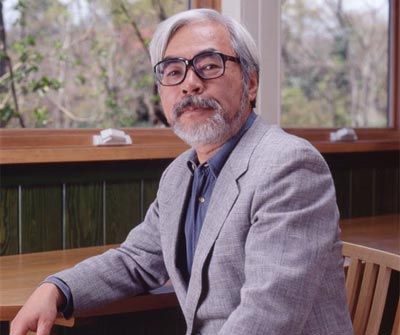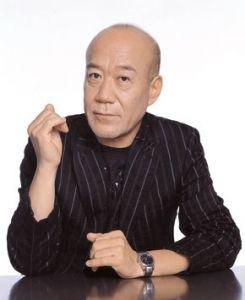|

Hayao Miyazaki
Miyazaki, the second of four brothers, was born in the town of Akebono-cho, part
of Tokyo's Bunkyō-ku. During World War II, Miyazaki's father Katsuji was director of Miyazaki Airplane, owned by his
brother (Hayao Miyazaki's uncle), which made rudders for A6M Zero fighter planes. During this time, Miyazaki drew airplanes
and developed a lifelong fascination with aviation, a penchant that later manifested as a recurring theme in his films.
Miyazaki's mother was a voracious reader who often questioned socially accepted
norms. Miyazaki later said that he inherited his questioning and skeptical mind from her. His mother underwent treatment for spinal tuberculosis from 1947 until 1955, and
so the family moved frequently. Miyazaki's film My Neighbor Totoro is set in that time period and features a family
whose mother is similarly afflicted.
Miyazaki attended Toyotama High School. In his third year there, he saw the film
Hakujaden, which has been described as "the first-ever Japanese feature length color anime". His interest in animation
began in this period; however, in order to become an animator, he had to learn to draw the human figure, since his prior work
had been limited to airplanes and battleships.
After high school, Miyazaki attended Gakushuin University, from which he would
graduate in 1963 with degrees in political science and economics. He was a member of the "Children's Literature research club,"
the "closest thing to a comics club in those days".
In April 1963, Miyazaki got a job at Toei Animation, working as
an in-between artist on the anime Watchdog Bow Wow
(Wanwan Chushingura). He was a leader in a labor dispute soon after his arrival, becoming chief secretary of Toei's
labor union in 1964.
In October 1965, he married fellow animator Akemi Ota, who later
left work to raise their two sons, Gorō and Keisuke. Gorō is now an animator and filmmaker, and has directed Tales
from Earthsea at Studio Ghibli. Keisuke is a wood artist who has created pieces for the Ghibli Museum and who made the
wood engraving shown in the Studio Ghibli film Whisper of the Heart.
Hayao Miyazaki's dedication to his work has often been reported to have impacted
negatively his relationship with his son Gorō.

Joe Hisaishi
Joe Hisaishi was born in Nakano, Nagano, Japan as Mamoru Fujisawa (藤澤 守 Fujisawa Mamoru). When he started to take violin lessons at age five, Hisaishi discovered his passion for music. Realizing his love,
he attended the Kunitachi College of Music to major in music composition in 1969. Hisaishi collaborated with music minimalists
as a typesetter, furthering his experience in the musical world.
He enjoyed his first success of the business in 1974, when he composed music for a small animation called Gyatoruzu.
This and other early works were created under his real name. During this period, he composed for Sasuga No Sarutobi
(Academy of Ninja) and Futari Taka (A Full Throttle).
In the 1970s, Japanese popular music, electronic music, and new-age music flourished - those genres, as well as the Yellow
Magic Orchestra (a Japanese electronic band in 1978-1983), influenced Hisaishi's compositions. He developed his music
from the ideals of minimalism and expanded toward orchestral work. Around 1975, Hisaishi presented his first public performance,
spreading his name around his community. His first album, MKWAJU, was released in 1981, with its first work, Information,
being released a year later.
As his works were becoming well-known, Hisaishi formulated an alias inspired by Quincy Jones, an African-American musician
and producer. The name, "Quincy Jones," was retranscribed in Japanese as "Joe Hisaishi." ("Quincy," pronounced "Kuishi" in
Japanese, can be written using the same kanji in "Hisaishi"; "Joe" comes from "Jones.") This pseudonym became part of Mamoru
Fujisawa and remains with him.
In 1983, with his new name, Hisaishi was recommended by a record company to create an album for Nausicaš of the Valley
of the Wind. Hisaishi and the director of the animated movie, Hayao Miyazaki, became great friends and worked together
on many projects. This big break led to Hisaishi fervently composing more Japanese movie soundtracks; in 1986, Laputa Castle
in the Sky was released; later, in the 1990s, Princess Mononoke and Spirited Away were revealed to the public.
Hisaishi cemented his reputation as one of the budding anime industry's top musical contributors and his compositions (including
eight theatrical films and one OAV) would go on to become one of the very hallmarks of early Anime in the 1980s and 1990s.
Hisaishi scored such TV series hits as Sasuga no Sarutobi, Two Down Full Base (both 1982), Sasrygar (1983), Futari Taka (1984)
and Honoo no Alpen Rose (1985). He also scored the sci-fi adventure Mospeada (1983), which was later reworked (without his
music) into the third segment of Carl Macek's compilation, Robotech. The remaining movies, in order of appearance, are Arion,
Totoro (1988), Venus Wars, Kiki's Delivery Service (1989), and Porco Rosso (1992).
As more exposure was given to Hisaishi and the anime industry, Joe Hisaishi's career grew. He not only started a solo
career as a musician, but he also started to produce music and create his own label (Wonder Land Inc.). A year later, the
label produced its first album, Pretender, in New York.
Because of his hard work throughout the years, Hisaishi has won the Japanese Academy Award for Best Music five times -
in 1992, 1993, 1994, 1999, and 2000. He also received the 48th Newcomer Award in 1997 from the Ministry of Education (Public
Entertainment Section) and many other music awards as a revered figure in the Japanese movie industry.
In 1998, he provided the soundtrack to the 1998 Winter Paralympics. In 1999, Hisaishi composed the music for the third
installment in a series of popular computer-animated educational films about the human body.
In 2001, Hisaishi produced music for Takeshi Kitano's film, Brother, and Hayao Miyazaki's masterpiece, Spirited
Away. He also served as executive producer of the Night Fantasia 4 Movement at the Japan Expo in Fukushima 2001. On October
6, Hisaishi made his debut as the film director for Quartet, in addition to writing both its music and script. Quartet
received excellent reviews at the Montreal Film Festival. His first soundtrack for a foreign film, Le Petit Poucet,
was released in the same year.
Another Miyazaki film, Howl's Moving Castle, for which Hisaishi composed the score, was released on November 20,
2004 in Japan. From November 3 to November 29, 2004, Hisaishi embarked on his "Joe Hisaishi Freedom - Piano Stories 2004"
tour with Canadian musicians. In 2005, he composed the soundtrack for the Korean film, Welcome to Dongmakgol (웰컴 투 동막골). Hisaishi has
a large fan base in Korea due to the popularity of Miyazaki films.
In 2006, Hisaishi released a studio album, Asian X.T.C., the compositions of which demonstrated a significantly
eclectic and contemporary style. The following year, he composed and recorded the soundtrack for Frederic Lepage's film, Sunny
and the Elephant, released in 2008, and also for the upcoming Miyazaki film, Ponyo on A Cliff, set to be
released in the summer.
In 2008, Hisaishi is composing the soundtrack for I Want to Be a Shellfish (我想成为贝壳/Watashi wa Kani ni Naritai), a post-World War 2 war crimes trial drama - based on the 1959
Tetsutaro Kato novel that was made into a film that same year - that is currently being remade and directed by Katsuo Fukuzawa,
starring Masahiro Nakai and Yukie Nakama.
|




